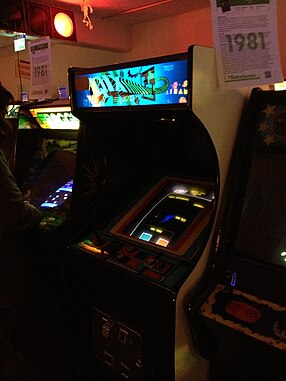Qix
| Qix | |||
|---|---|---|---|
| Studio | Taito | ||
| Publisher | Taito | ||
| Senior Developer | Randy Pfeiffer , Sandy Pfeiffer | ||
| Erstveröffent- lichung |
1981 | ||
| genre | Action game , puzzle game | ||
| Game mode | Up to 2 players take turns | ||
| control | 4-way joystick ; 2 buttons | ||
| casing | Standard and Cocktail | ||
| Arcade system | M6809 , 1.25 MHz | ||
| monitor | Grid , resolution 240 × 256 pixels | ||
| Age rating | |||
| information | The first arcade game designed by a woman | ||

Qix is an arcade game that 1,981 of the Taito America Corporation was published.
Overview
At the beginning of each level, the playing field only appears as an empty, black rectangle that contains Qix. This is an object formed from several lines that moves within the playing field in different processes. The player controls a small point that can move on the edge of the rectangle. The aim of Qix is to take up at least 75% of the playing field.
In order to take possession of a part of the playing field, the player must draw so-called stix. Stix are just straight lines that can be drawn by moving the point. If you describe a closed figure with these lines, the content is filled and the area then belongs to the player. There is also the option of drawing slow or fast Stix, which are marked blue or red.
Faster Stix can be completed more quickly and with less risk, but earn fewer points, which is exactly the opposite for slower ones. If one of the lines of the Qix touches an unfinished Stix, the player loses a life.
If the player has claimed an area for himself, he can move safely with the point on its edge. This procedure is repeated until the player has covered at least 75% of the entire playing field.
The game designers were Randy and Sandy Pfeiffer .
opponent
There are three main categories of opponents, all of which are dangerous for the player:
- The most common type is called Qix. The Qix can only hit the player when he is drawing a stix. If the Qix touches one of the lines of the Stix while the player is drawing, the player loses a life.
- Sparx are small sparks that move around the edge of the playing field and every edge of the area confiscated by the player. They don't just move along the edge in any pattern. If the player is touched by a Sparx, he loses a life. Sparx cannot walk on lines that are being drawn.
- The fuse appears if the player - while drawing a new stix - pauses. They are similar to Sparx, but they only wander along the lines of Stix. If a fuse touches the player, he loses a life. However, it immediately disappears as soon as the player starts moving again.
Implementations
- Commodore 64
- Apple II (1989)
- Apple IIgs (1990)
- Atari 5200 (1982)
- Atari Lynx (1991)
- Game Boy (1990)
- KC 85
- NES (1990)
chronology
Super Qix was released in 1989, Twin Qix in 1995. Because of the simplicity of the game principle, many offshoots have been produced for mobile phones , PCs and other platforms. In addition, there are numerous similar variants, also in 3D optics, for example AirXonix for the PC or Cubixx (2009) for PlayStation Portable and PlayStation 3 . The same game principle is used in the arcade game Volfied (Taito, 1989).
Web links
- Qix in the Killer List of Video Games (English)
- Qix at MobyGames (English)
- Online version of Qix ( Flash ; 94 kB)
